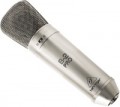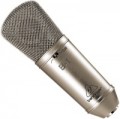Microphone directivity
Directionality describes the ability of a microphone to pick up sounds coming from different directions, more precisely, the dependence of sensitivity on the direction from which the sound comes.
—
Unidirectional. As the name implies, these microphones are capable of picking up sound coming from only one side. Note that the coverage area itself can be quite wide, but anyway it is located “in front” of the microphone. Unidirectional models are very convenient for the perception of sound from a single source, with maximum clipping of ambient noise.
—
Bidirectional. This term in our case means two types of microphones. The first option is the classic bidirectional models, designed for the possibility of normal perception of sound from two opposite sides — roughly speaking, "front" and "rear"; at the same time, dead zones are formed on the sides, from where the sound is practically not perceived. This format of work can be useful, for example, for broadcasting a dialogue in a radio station studio, or when simultaneously recording two voices on one microphone. The second variety is microphones with a pair of capsules directed at an angle to each other (most often perpendicular); a similar design is used in models with a stereo recording function.
—
Omnidirectional. Also, this variety is called "non-directional", which also to a certain extent ch
...aracterizes its features. Such microphones do not have a clearly defined directionality — they perceive the sound coming from any direction with full sensitivity. An example of a situation where this format might be useful is a recording of a roundtable discussion.
Note that while most microphones only work in one directional pattern, some models support multiple directional patterns, with the ability to switch between them as desired by the user (see Features/Characteristics). The methods of such switching can be different: in some models it is enough to move the switch, in others you need to change the capsule.Rated resistance
Microphone AC impedance; this parameter is also called "impedance". This is one of the most important characteristics that determines compatibility with the amplifier or other device to which the microphone is connected: if the impedance is not optimal, there may be a loss in signal power. It has its own characteristics, depending on the purpose of a particular model (see above). So, for microphones used with computers, laptops, voice recorders and phones / tablets, the impedance may not be indicated at all — the characteristics of such models are selected in such a way as to ensure normal compatibility with the corresponding devices. But in professional audio equipment, special rules are used for selection; more details can be found in special sources.
Sensitivity
Sensitivity describes the signal strength at the output of a microphone when it processes a sound of a certain volume. In this case, sensitivity means the ratio of the output voltage to the sound pressure on the membrane, expressed in decibels. The higher this number, the higher the sensitivity. Note that, as a rule, values in decibels are negative, so we can say this: the closer the number is to zero, the more sensitive the microphone. For example, a -38 dB model outperforms a -54 dB model in this parameter.
It should be borne in mind that high sensitivity in itself does not mean high sound quality - it only allows the device to “hear” a weaker sound. Conversely, low sensitivity is not an unequivocal sign of a bad microphone. The choice for this parameter depends on the specifics of the application: a sensitive device is useful for working with low sounds and in cases where it is necessary to capture the smallest nuances of what is happening, and a “weak” microphone will be convenient at high sound volume or, if necessary, filter out extraneous weak noises. There are models with
sensitivity adjustment(and for models with a headphone output
, headphone volume control may be provided).
Signal to noise ratio
A parameter that describes the relationship between the useful signal level and the noise level produced by the microphone. Note that the actual signal-to-noise ratio varies depending on the sound pressure perceived by the microphone. Therefore, in the characteristics it is customary to indicate the option for a standard situation — at a sound pressure of 94 dB. This allows you to compare different models with each other.
In general, this indicator quite clearly characterizes the quality of work of a particular model, since it takes into account almost all significant extraneous noise that occurs during operation. The greater this ratio, the clearer the sound is, the less distortion it has. Values of 64 – 66 dB are considered quite decent, and high-end microphones provide performance of 72 dB and higher.
Features
—
Wireless connection. This feature is indicated for the so-called radio microphones — models in which the signal is transmitted wirelessly. Note that a radio microphone kit usually involves a receiver that is connected to an amplifier (or other sound processing device) in a classic wired way (see "Connection connectors"). However, the microphone itself is connected to the receiver via a radio channel.
—
Stereo recording. The ability to use a microphone to record sound in stereo format. This format assumes the presence of two channels, and for each of them the sound must be recorded separately; but the technical support of such a recording in different cases may vary. The most popular option is bi-directional microphones. However, in addition to this, this category includes paired sets for which the stereo recording function is directly claimed.
—
LPF (Roll-off). The presence of a low-pass filter in the design of the microphone (Roll-off is an alternative name for this function). This feature allows you to reduce the level of low frequencies in the signal produced by the microphone. This need may be due to two factors. Firstly, many extraneous noises are the sound of the wind, knocks on the device case, the surrounding background, etc. — are presented at low frequencies; by suppressing this range, you can significantly reduce the level of extraneous so
...unds “heard” through the microphone. Secondly, the LPF is useful for working with the so-called "proximity effect". This effect consists in the fact that when approaching the sound source, many models tend to increase the volume of the bass sound, and when removed, on the contrary, they fail the “bass”. By turning on Roll-off when approaching the sound source and turning it off when moving away, this effect can be smoothed out to a certain extent. For a number of technical reasons, this function is mainly used in condenser and electret microphones (see "Type"). Note that in advanced models, the low-pass filter can be made customizable and supplemented with an auxiliary ultra-low pass filter.
— Attenuator. The presence of an attenuator in the design of the microphone — a device that gradually attenuates the signal level at the output (a kind of opposite to an amplifier). This feature is useful when working with loud sound: by lowering the signal level, you can avoid overloading the system.
— Sensitivity adjustment. The presence of its own sensitivity control in the design of the microphone. This function allows you to adjust the signal level without using the controls in other components of the audio system — for example, to change the volume on the fly; this is quite convenient, since the microphone is usually at hand, and settings can be changed very quickly and without much hassle.
— Headphone volume adjustment. A separate knob for adjusting the volume of connected headphones (see "Headphone output"). Depending on the model, it can be placed both on the microphone itself and on the receiver for wireless connection. Anyway, this feature makes adjusting the volume more convenient: the control is at hand and the user does not need to reach for other devices or delve into the software settings.
— Mute the microphone. The presence of its own switch in the design of the microphone. In some use cases, it is not uncommon for situations where the microphone has to be constantly turned on and off. For example, during a concert, the number of performers may change, and it is better to turn off unused microphones; when communicating via Skype through a computer, sometimes you have to be distracted by conversations with others that the “computer” interlocutor does not need to hear, etc. Usually, muting the microphone is possible through the settings or control panel of the device to which it is connected; however, using your own switch is usually easier and faster, especially if you have to mute / unmute the sound frequently.
— Built-in memory. The presence of built-in data storage in the microphone eliminates the need to use external storage media to record sound. On-board storage is found in some models of advanced “lavaliers”, microphones for video cameras and voice recorders - i.e. in portable solutions with a view to comfortable work in the field.
— Switching DN. DN in this case means “directional pattern”, however, this function may mean switching not only between options for a unidirectional microphone (see “Directional Pattern”), but also between one-, two- and omnidirectional operation format (see “Directionality”). microphone"). Therefore, specific switching features and available options should be clarified for each model separately.
